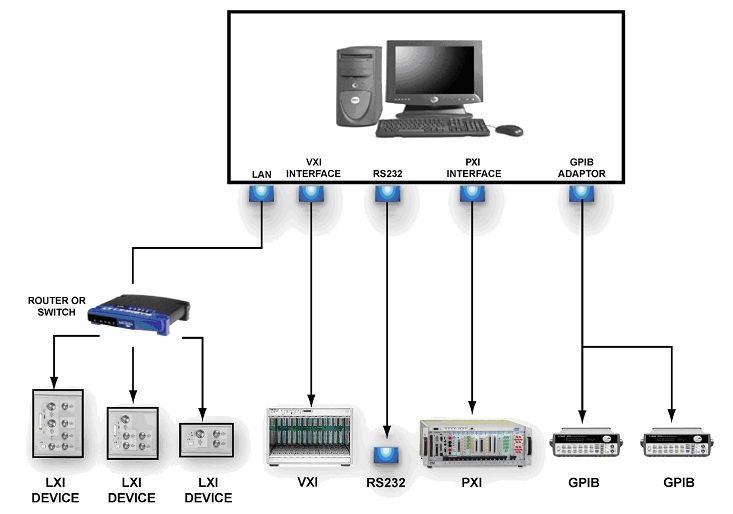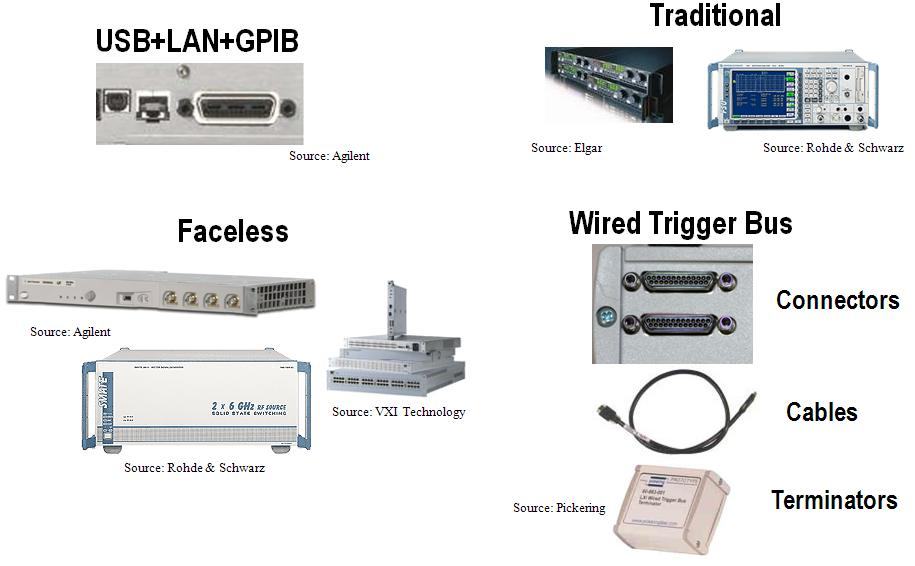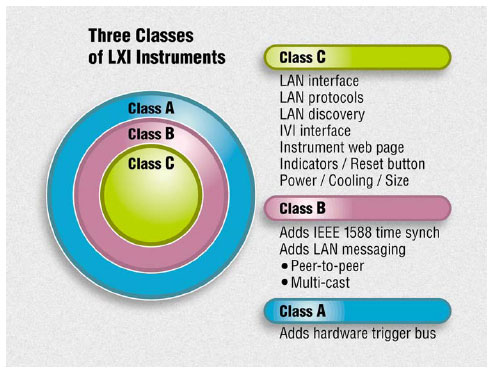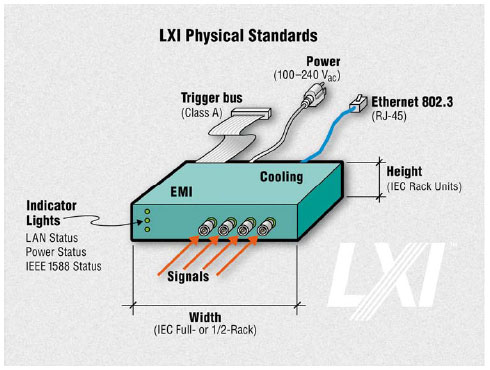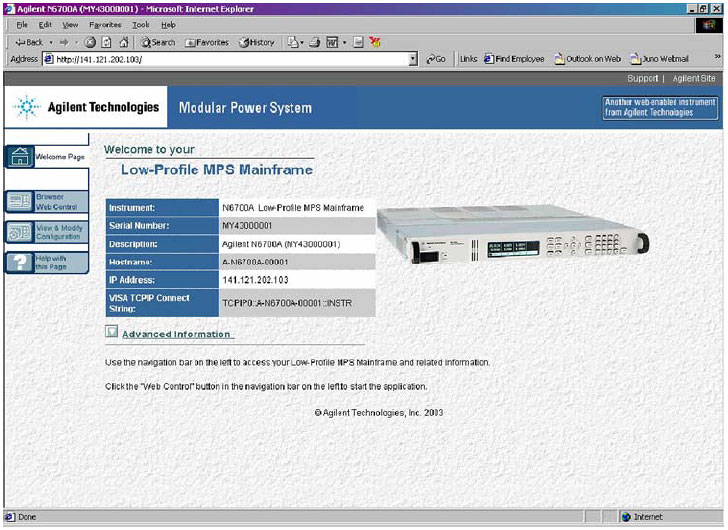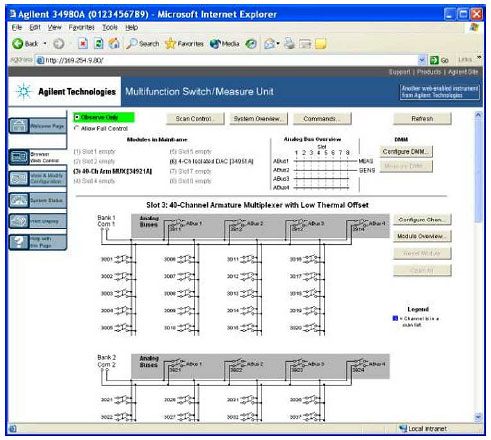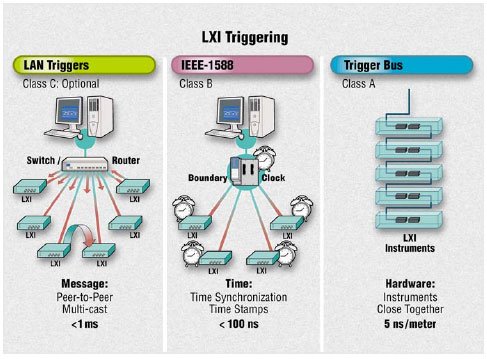| www.tmatlantic.com
Test & Soldering Equipment On-line Store |
|
D.E.V.I.C.E. (Wiki)Calculators Services |
|||||
Filter by first letter
|
LXI (LAN eXtensions for Instrumentation)
LXI (LAN eXtensions for Instrumentation) is a flexible high-speed standard for communication protocols for measuring and collecting data for devices using a universal LAN (Ethernet) interface, developed by the industry LXI consortium. The main goal of the LXI consortium is to ensure compatibility of newly developed control and measuring devices by various manufacturers, as well as to guarantee support for existing GPIB, VXI and PXI interfaces. See APS-7306L(S) as an example of aplication.
The main requirements for LXI devices are: cost-effectiveness, compactness, ease of operation, upgradeability and reconfiguration, as well as, high performance. In practice, they are usually modular, without controls and a display on the front panel, use an autonomous power supply and have a driver for an interchangeable virtual instrument (IVI). Connectors for input and output signals are located on the front panel of the modules, while the local network interface (IEEE 802.3), power connectors and synchronization buses are located on the rear panel. All modules have standard dimensions for installation in 19" racks or a stack. [4] The main areas of application of systems based on the LXI standard are automated measuring systems, remote data collection and production process control systems, robotics and many others.
LXI ConsortiumThe LXI standard was developed by an open, non-profit association of more than 40 leading manufacturers and consumers of test and measurement equipment: Agilent Technologies, Tektronix, Rohde&Schwarz, Keithley Instruments, Racal Instruments, Yokogawa, etc. [6] The first meeting of the consortium was held on November 17-18, 2004. Membership in the organization was divided into four levels: strategic, participating, consulting, and informational. The working group meetings are held several times a year at PlugFests held around the world. Anyone interested (both manufacturers and consumers) can attend consultations and receive information about changes in specifications and trial implementations, as well as certify new LXI products in test labs. [3] History of Creation
In addition to the XML development, the 2.0 feature set will undergo significant changes: web interface extensions, interactive testing (LAN peer-to-peer messaging, IEEE 1588 time synchronization, LXI Class A wired instrument trigger bus), full event logging, resource sharing across multiple controllers, standardized script loading, and increased throughput. Components of the LXI StandardThe LXI standard contains the following main sections:
LXI Device ClassesClass C is the basic Class. Class B devices have additional capabilities for LAN triggering and synchronization support. Class A satisfies the requirements of Classes C and B with the addition of a hardware synchronization bus with low transmission latency (this bus provides the highest possible response time to a trigger event) [17].
Class C: Class C is the basic LXI class, all other classes must meet its requirements. Equipment of this class has network detection and configuration functions, has a Web interface, supports Ethernet protocols and meets the physical requirements of the standard. Devices do not impose requirements for triggering events/processes. Allows hardware triggering tools and LAN triggering used by individual manufacturers. Class B: Class B equipment meets all Class C requirements, has LAN triggering capability, and supports the IEEE 1588 clock protocol. The LXI standard uses point-to-point and broadcast modes of LAN event/process triggering specifically for device and instrument triggering, giving LXI systems flexibility not available in previous architectures. In IEEE 1588, LXI Class B devices synchronize their clocks to achieve a single measurement or output timing without the need for special synchronization cables and the ability to time-stamp all events and data. IEEE 1588 combined with LAN triggering allows the transmission of timing information and data without the need for a real-time computer. The potential of these capabilities is still being explored. Class A: Class A equipment meets all the requirements of Classes C and B, with the addition of a hardware trigger bus. The eight-channel M-LVDS (Multipoint-Low Voltage Differential Signaling) hardware bus can connect closely spaced devices in a daisy chain, star, or a combination of the two topologies. The trigger bus ensures signal transmission between devices with extremely low latency – about 3 ns/m. [18] LXI Device InterfacesThe basis of the LXI bus is LAN. But instead of modifying existing standards, the LXI standard clearly defines their interaction in five areas: physical interface, Ethernet interface, software interface, WEB interface and synchronization. [1] 1) Physical interface
To ensure physical compatibility, the LXI standard requires compliance with standard (IEC) rack physical dimensions. Specific connections are recommended on the front and rear panels to simplify integration. Each module must meet standard EMI shielding and cooling requirements applicable worldwide. 2) LAN interfaceUsing specialized LAN equipment, IEEE-1588 devices are capable of achieving time synchronization within ±100 ns, which is especially important when devices are located over large distances from each other. [19], [3] The IEEE 802.3 standard is used to define the appropriate connections, protocols, speeds, addresses, configurations, and other conditions that must be implemented to ensure interoperability in a system. Table 1 – Comparison of LAN and LXI device functions
LXI devices must operate properly on an Ethernet network that is equal to or slower than the devices themselves. Table 2 – Ethernet speed requirements for proper operation
LAN Configuration
3) Programming interfaceSince the LXI standard requires all devices to have an IVI driver, it allows the user to use the programming language or development environment of their choice. IVI-COM and IVI-C are the recognized standard drivers that instrument manufacturers supply with their products. 4) Web interfaceEach LXI-compliant device has its own web page. This page contains key information about the device, including the manufacturer, model number, serial number, description, host name, MAC address, and IP address. The standard requires that the configuration page be accessible via a web browser. This allows the user to change various parameters. Web pages are accessed by entering the IP address in the address bar of any W3C-compliant browser. HTTP connections are made over port 80. The home page is returned in response to such connection requests.
The web interface should also provide an additional IP configuration page and a synchronization page (if the device uses IEEE 1588, LXI Event Messaging, or LXI Trigger Bus). If the LXI device allows the user to change any settings, password protection should be implemented. LXI devices can be assigned aliases to make them more convenient for users, for example when devices of the same type are included in one system. [6], [3], [22] LXI devices must output an HTML Web page that works correctly with all W3C compliant browsers. LXI device Web servers must comply with the HTTP standard (version 1.0 or higher). HTML pages must comply with HTML (version 4.01 or higher) or XHTML (version 1.0 or higher). The main page contains the following information in read-only mode:
The main page must contain an IVI I/O Resource Descriptor - a string that defines the address by which the software accesses the device. This string is called the "Device Address String". The LXI device Web page header is formatted for easy bookmarking as follows: LXI - Manufacturer - Model - <Optional: serial number - description>. The device Web page displays the device operation/status indicator. LXI devices shall provide the ability to interact, control, install and debug via a Web interface without writing a program. If necessary, LXI devices shall have the ability to update software/firmware using a Web interface.. [20], [3] 5) SynchronizationBy combining the capabilities of LAN and the IEEE 1588 time synchronization protocol, the LXI standard defines trigger modes:
Features of working with LXIIn terms of measurement capabilities, LXI instruments and rack-and-stack instruments are identical. They use the same measurement methodology, have the same specifications, offer the same features, and use the same software. The difference is in the case: standard instrument racks are designed for stand-alone operation (without a PC) and have a user control panel. These same devices without a case and display can be installed in a rack and work with a PC. LXI modules are PC-controlled and connected to a measuring system. They have no front panel, all signal terminals are located on the front, and power and switching terminals are on the back side. LXI instruments have several advantages over rack-mounted instruments. When used over a local area network, LXI supports peer-to-peer operations, which opens the door to combined instruments and simultaneous operations, speeding up measurements and reducing costs. The test industry has incorporated some of the features of VXI, PXI, and MMS into the LXI architecture. Because modular instruments represent only a portion of the test equipment market, specialized modular instruments can be expensive and inefficient. Specialized applications often require custom-designed instruments that have little in common with similar industry-standard models. Design costs fluctuate within a narrow range, and the narrow distribution footprint limits revenue growth. By giving customers the performance, software, improved compatibility with full-featured instruments, and lower cost, LXI instruments are becoming increasingly popular. [5] List of devices using LXI technology
and more… Advantages of LXI devices
Sources of information
Appendix AFull list of LXI consortium membersStrategic partners
Members
Consultants
Information partners
Universities
|
Measurement History Events
|
Site mapPrivacy policyTerms of Use & Store PoliciesHow to BuyShippingPayment




|





















